《英语修辞学》第一章
- 格式:ppt
- 大小:1.45 MB
- 文档页数:52
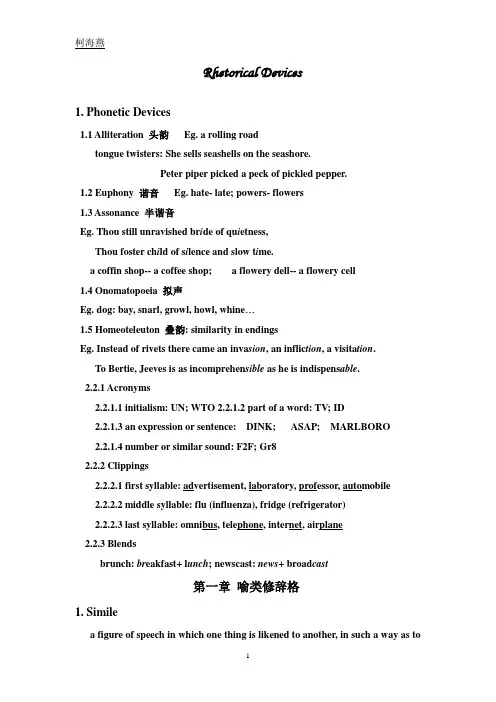
Rhetorical Devices1. Phonetic Devices1.1 Alliteration 头韵Eg. a rolling roadtongue twisters: She sells seashells on the seashore.Peter piper picked a peck of pickled pepper.1.2 Euphony 谐音Eg. hate- late; powers- flowers1.3 Assonance 半谐音Eg. Thou still unravished br i de of qu i etness,Thou foster ch i ld of s i lence and slow t i me.a coffin shop-- a coffee shop; a flowery dell-- a flowery cell1.4 Onomatopoeia 拟声Eg. dog: bay, snarl, growl, howl, whine…1.5 Homeoteleuton 叠韵: similarity in endingsEg. Instead of rivets there came an inva sion, an inflic tion, a visita tion.To Bertie, Jeeves is as incomprehen sible as he is indispens able.2.2.1 Acronyms2.2.1.1 initialism: UN; WTO 2.2.1.2 part of a word: TV; ID2.2.1.3 an expression or sentence: DINK; ASAP; MARLBORO2.2.1.4 number or similar sound: F2F; Gr82.2.2 Clippings2.2.2.1 first syllable: advertisement, laboratory, professor, automobile2.2.2.2 middle syllable: flu (influenza), fridge (refrigerator)2.2.2.3 last syllable: omnibus, telephone, internet, airplane2.2.3 Blendsbrunch: br eakfast+ l unch; newscast: news+ broad cast第一章喻类修辞格1. Similea figure of speech in which one thing is likened to another, in such a way as toclarify and enhance an image. It is explicit comparison (as opposed to the metaphor where comparison is implicit) recognizable by the use of words “like”or “as”.1.2常用的比喻词有as, like, seem, as if, as though, such as 等。

蓝纯英语修辞学,理论与实践课后答案及解析第1章
(一)名词解释
(二)1.口头语言口头语言是以人类用发音器官发出的声音(语音)为形式的符号系统。
它是指音与义结合而成,以说和听为传播方式的有声语言。
2.教师语言教师语言是教师传道、授业、解惑以及与学生交流、联络感情的重要工具。
3.语言的生活化语言的生活化,是指幼儿教师在组织幼儿活动时应当较多使用非概念化的生活交际语言。
语言的生活化是由幼儿教育内容的生活化所决定的。
(三)简答题1. 简述教师口语的性质。
教师口语的性质,国家教育部在《师范院校教师口语标准》中明确规定,“是研究教师口语运用规律的一门应用语言学科,是在理论指(全文还有8976字)
课内练习答案
第一章翻译理论第一节翻译的基本原理课前活动第一句来自自马克吐温《密西西比河上的生活》。
原文是优美的景物描写。
(见“补充文字材料”。
)译文1没有翻译出原文风格;译文2是百度翻译的,完全不通顺。
译文3较好地做到了信达雅。
第二句来自一篇科普文章。
第一个翻译文白间杂,滥用四字成语,不符合原文的语体风格。
第二个较好地做到了“信达切”,但对kingdom的词义选择有误。
第一二句分别属于不同的genre(体裁),这就意味两个文本的语体风格不同:第一个语篇为散文语体,第二个语篇为说明文,因此属于不同的register(语域,指因使用场合、对象、领域等不同有不同的语体;语(全文还有9816字))。
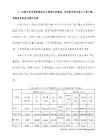
普通高等教育“十五”国家级规划教材现代英语修辞学Moder n English Rhetor ic胡曙中编著上海外语教育出版社图书在版编目(CIP)数据现代英语修辞学/胡曙中编著.—上海:上海外语教育出版社,2004ISBN7-81095-185-8Ⅰ.现…Ⅱ.胡…Ⅲ.英语修辞教材Ⅳ.H315中国版本图书馆CIP数据核字(2004)第014498号早在1982年,我的导师杨小石先生有意要编一本适合我国英语专业使用的英语修辞学教材,为此,他邀请了包括我在内的三位教师一起参加编写,我们商定了编写大纲,也作了具体的分工。
我当时只有35岁,对编写这么一本教材的困难程度并不清楚,但却凭着一股劲,居然勉强地完成了自己那一部分,但是由于他们未能完成自己的部分,我的那一部分最后也就不了了之了。
从那时到现在,时间过去了20多年。
在这20多年中,我读了一些书,作了一些研究,从《英汉修辞比较研究》、《美国新修辞学》到《英语修辞学》,我走了过来。
坦诚地说,前面走过的路不都是一步一个脚印的,但就在这步履艰难的过程中,我逐渐知道了什么是英语修辞,知道了如何来阐释和应用英语修辞。
现在奉献给大家的这本《现代英语修辞学》,承蒙教育部和有关专家的厚爱,被确定为普通高等教育“十五”国家级规划教材。
我把这本书写成一本英语修辞学的入门书,是想回答许多学生提出的问题:“什么是英语修辞学?”“英语修辞学是不是就是研究英语写作?”“英语修辞学是英语专业的课程,还是语言学的课程?”我希望我的这本书能较为满意地回答这些问题。
在这儿,我想概括一下本书的各章内容和目的:第0章导论解释英语修辞的种种意义,并说明本书的目的———对英语修辞现象的描述、应用和阐释第1章影响修辞活动的要素论述信息、使用场合、受话者之间的关系,说明语气如何反映其间的关系第2章词汇的修辞描述英语选字遣词的修辞规律及其应用第3章句子的修辞描述英语连词组句的修辞规律及其应用第4章 段落的修辞 描述英语段落构成的修辞规律及其应用第5章 语篇的修辞 描述英语语篇构成的修辞规律及其应用第6章 语篇的种类 描述语篇的种类及其特点第7章 语体 描述作为修辞活动综合体的语体特征第8章 修辞手段 描述修辞布局和辞格的规律第9章 理论阐释 简述主要的英语修辞理论第10章 传统与发展 回顾英语修辞学的传统,预测其发展本书主要适合英语专业高年级学生和研究生使用。
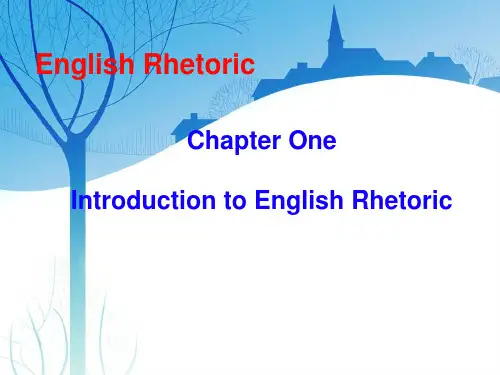
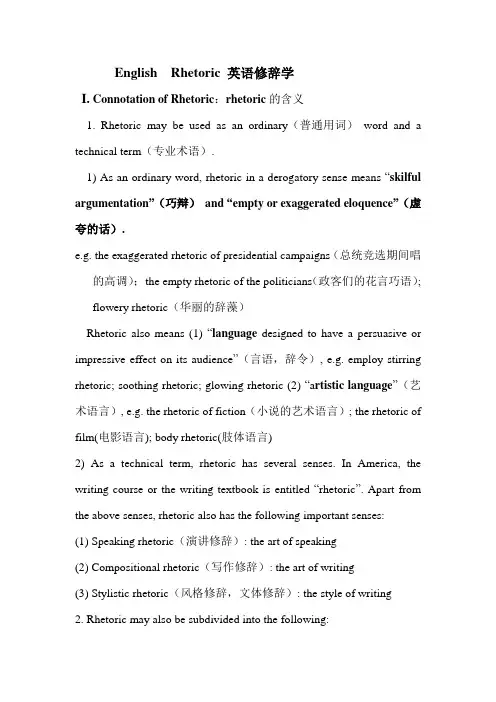
English Rhetoric 英语修辞学I. Connotation of Rhetoric:rhetoric的含义1. Rhetoric may be used as an ordinary(普通用词)word and a technical term(专业术语).1) As an ordinary word, rhetoric in a derogatory sense means “skilful argumentation”(巧辩)and “empty or exaggerated eloquence”(虚夸的话).e.g. the exaggerated rhetoric of presidential campaigns(总统竞选期间唱的高调);the empty rhetoric of the politicians(政客们的花言巧语);flowery rhetoric(华丽的辞藻)Rhetoric also means (1) “language designed to have a persuasive or impressive effect on its audience”(言语,辞令), e.g. employ stirring rhetoric; soothing rhetoric; glowing rhetoric (2) “a rtistic language”(艺术语言), e.g. the rhetoric of fiction(小说的艺术语言); the rhetoric of film(电影语言); body rhetoric(肢体语言)2) As a technical term, rhetoric has several senses. In America, the writing course or the writing textbook is entitled “rhetoric”. Apart from the above senses, rhetoric also has the following important senses:(1) Speaking rhetoric(演讲修辞): the art of speaking(2) Compositional rhetoric(写作修辞): the art of writing(3) Stylistic rhetoric(风格修辞,文体修辞): the style of writing2. Rhetoric may also be subdivided into the following:1) Lexical rhetoric(词汇修辞):the rhetorical law of choosing words and phrases2) Sentence rhetoric(句子修辞):the rhetorical law selecting sentence patterns3) Paragraph rhetoric(段落修辞):the rhetorical law of organizing paragraphs4) textual rhetoric(语篇修辞):the rhetorical law of organizing textsII. Definition of Rhetoric修辞学的定义What is rhetoric ?1.Origin of modern rhetoric: 现代修辞学的起源Rhetoric originated in “speaking”(说话). Aristotle(亚里士多得), in the 4th century BC, first defined rhetoric as the art of persuasion, equivalent to argumentation as people understand today. John Locke(约翰.洛克), English philosopher of the late 17th century, described rhetoric as “the science of oratory(演说术)” or “the art of speaking with propriety, elegance and force(修辞学是说话得体、优美和有力的艺术)”. All this explains why the word “rhetoric” means “speaking”in such European languages as Greek, Latin, French, Spanish and Italian. In the book Modern Rhetoric by American linguists Brooks(布鲁克斯)and Warren(沃伦)rhetoric is defined as “the art of using language effectively(修辞学是有效地使用语言的艺术)”.In the New Oxford Dictionary of English rhetoric is described as “the art of effective or persuasive speaking or writing, especially the exploitation of figures of speech or other compositional techniques(修辞学是有效或有说服力的演说或写作的艺术,特别是运用英语修辞格或其它写作的艺术)”.2.Rhetoric and Figures of Speech:Figures of speech are quite different from rhetoric, but they are important components in English rhetoric. In the New Oxford Dictionary of English, “figure of speech” is defined as “ a word or phrase used in a non-literal sense too add rhetorical force or interest to a spoken or written passage”(修辞格是用一个非字面意义的单词或短语使一段口头或笔头的文字增加修辞效果或兴趣). They refer to rhetorical devices(修辞手段), each of which has a fixed pattern, e.g. Simile is introduced by comparative words as, like, as if, as though, etc.; Like Simile, Metaphor refers to the comparison of two essentially unlike things which have one point of resemblance;Irony refers to the intended implication of which is the opposite of the literal sense of words; Oxymoron refers to the conjunction of two words or phrases which are incongruous or contradictory in sense so as to describe a person or thing; Pun; a play on words, sometimes on different senses of the same word and sometimes onthe similar sense or sound of different words; etc. These figures are employed in the following.He is as stupid as a goose. (=He is very stupid.)He has a heart of stone./ He has a heart like flint.(=He is unfeeling and stubborn.)He slept like a log / top. (=He slept very soundly.)They are birds of a feather. (=They are people of the same sort.) (Simile and metaphor are used of the comparison of two essentially unlike things which have one point of resemblance.) This hard-working boy seldom reads more than an hour per week. (If a boy seldom reads more than an hour per week, he must be very lazy, not hard-working.)(Irony refers to the intended implication being the opposite of the literal sense of words)He seems to be a clever fool. (=He seems to be a fool, but in fact he is very clever.)(Oxymoron refers to the conjunction of two words or phrases which are incongruous or contradictory in sense)Ask for me tomorrow and you shall find me a grave man.(grave: adj. serious; n. tomb The speaker stresses the latter.) (Pun refers to a play on words,sometimes on different senses of the same word and sometimes on the similar sense or sound ofdifferent words)3.The difference between rhetoric and grammar, phonetics,lexicolog y1)The difference between rhetoric and grammarRhetoric is different from grammar, but it is closely related to grammar and also based on grammar. To be grammatically correct is foundation to writing, but it is not enough. Basic rhetorical requirements must also be met. Francis Christensenn, an American French rhetorician, once said:Grammar maps out the possible(计划可能发生的事情);rhetoric narrows the possible down to the desirable and effective (使可能发生的事情变成很理想的事情或有效地事情).In the preface to the book A handbook of English Rhetoric Warren quoted a passage by a scholar:Grammar is the law of language, considered as language;rhetoric is the art of language, considered as thought.Grammar tells what is correct; rhetoric tells what is effective and pleasing.2)Rhetoric and phonetics, lexicologyRhetoric is quite different from phonetics and lexicology. Phonetics is about the study of speech sounds and their pronunciation;lexicology is about the study of the vocabulary of a language;grammar concerns the study or science of rules for forming words and combining them into sentences; whereas rhetoric is the art of speaking or writing so as to persuade people effectively.I II. The Object of the Study of Rhetoric(修辞学研究的内容)Rhetoric aims at studying all forms of culture, which may be forms of mass media or any cultural phenomenon, concrete or abstract. Modern rhetoric seems to include all forms of discourse ---- written or colloquial, even all forms of communication in symbols.(修辞学研究的对象是一切文化形式,它们可以是任何这样或那样、具体或抽象的文化现象。
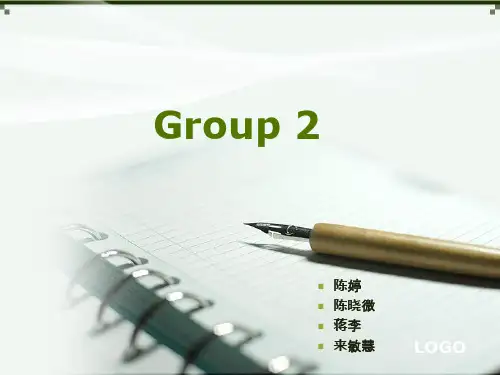
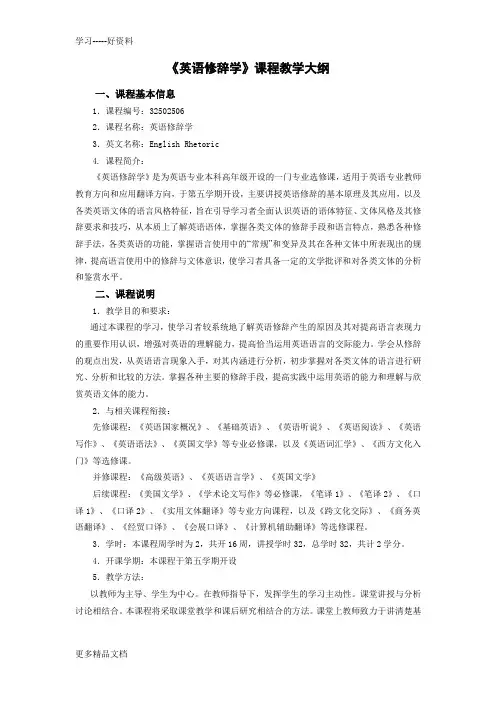
《英语修辞学》课程教学大纲一、课程基本信息1.课程编号:325025062.课程名称:英语修辞学3.英文名称:English Rhetoric4. 课程简介:《英语修辞学》是为英语专业本科高年级开设的一门专业选修课,适用于英语专业教师教育方向和应用翻译方向,于第五学期开设,主要讲授英语修辞的基本原理及其应用,以及各类英语文体的语言风格特征,旨在引导学习者全面认识英语的语体特征、文体风格及其修辞要求和技巧,从本质上了解英语语体,掌握各类文体的修辞手段和语言特点,熟悉各种修辞手法,各类英语的功能,掌握语言使用中的“常规”和变异及其在各种文体中所表现出的规律,提高语言使用中的修辞与文体意识,使学习者具备一定的文学批评和对各类文体的分析和鉴赏水平。
二、课程说明1.教学目的和要求:通过本课程的学习,使学习者较系统地了解英语修辞产生的原因及其对提高语言表现力的重要作用认识,增强对英语的理解能力,提高恰当运用英语语言的交际能力。
学会从修辞的观点出发,从英语语言现象入手,对其内涵进行分析,初步掌握对各类文体的语言进行研究、分析和比较的方法。
掌握各种主要的修辞手段,提高实践中运用英语的能力和理解与欣赏英语文体的能力。
2.与相关课程衔接:先修课程:《英语国家概况》、《基础英语》、《英语听说》、《英语阅读》、《英语写作》、《英语语法》、《英国文学》等专业必修课,以及《英语词汇学》、《西方文化入门》等选修课。
并修课程:《高级英语》、《英语语言学》、《英国文学》后续课程:《美国文学》、《学术论文写作》等必修课,《笔译1》、《笔译2》、《口译1》、《口译2》、《实用文体翻译》等专业方向课程,以及《跨文化交际》、《商务英语翻译》、《经贸口译》、《会展口译》、《计算机辅助翻译》等选修课程。
3.学时:本课程周学时为2,共开16周,讲授学时32,总学时32,共计2学分。
4.开课学期:本课程于第五学期开设5.教学方法:以教师为主导、学生为中心。
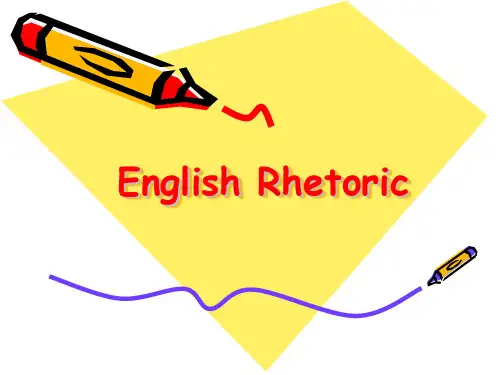
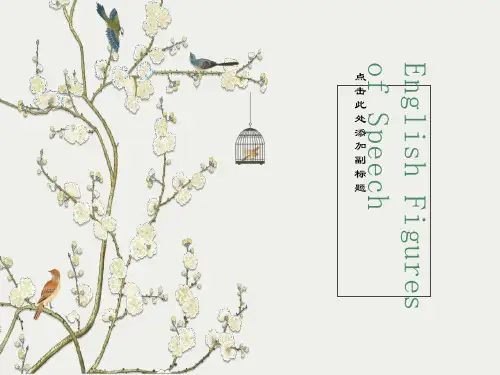
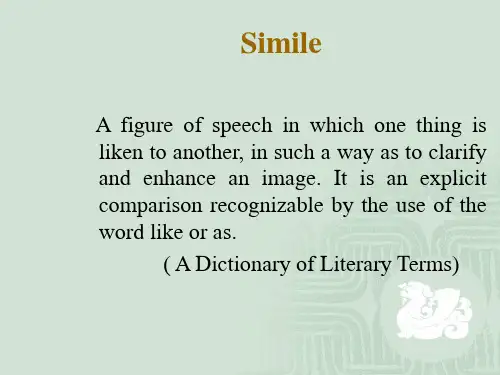
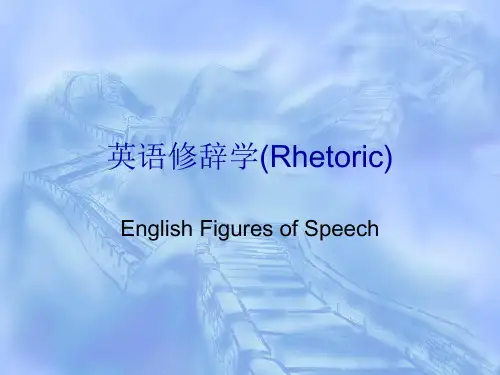
英语修辞学一、课程说明课程编号:180138Z10课程名称:英语修辞学/English Rhetorics课程类别:专业教育(选修)课学时/学分:32学时/2学分先修课程:议论文写作适用专业:英语专业教材、教学参考书:教材:自编教材教学参考书:Bizzell, Patricia. The Rhetorical Tradition: Readings from Classical Times to the Present. Boston, MA: Bedford/St Martin’s, 2001.Harris, Robert. Writing with Clarity and Style: A Guide to Rhetorical Devises for Contemporary Writers. Pyrczak Pub., 2002.Mcguigan, Brendan. Rhetorical Devises: A Handbook and Activities for Student Writers. Prestwick House, Inc., 2007.Samuelsen, Patricia. The Writer’s Toolbox: Use Rhetorical Devises to Improve Communication. Sweetwater Publishing, 2011.冯翠华.《英语修辞大全》. 外语教学与研究出版社,2005.兰纯.《修辞学:理论与实践》.外语教育与研究出版社,2013.二、课程设置的目的与意义作为英语专业选修课程,本课程设置的目的在于帮助学生掌握修辞理论和修辞手段,从而从修辞的角度提高对英语语言的理论认知。
修辞学是一门跨学科的课程,广泛吸收了哲学、文学、心理学领域的理论知识,是英语语言研究重要的一个分支。
修辞理论知识是英语专业学生和学者听、说、读、写、译等语言活动起着重要的指导作用。
英语修辞学课后答案第一章1、2.I think Game of Thrones is ________ TV series of the year. [单选题] * A.excitingB.more excitingC.most excitingD.the most exciting (正确答案)2、You cannot see the doctor _____ you have made an appointment with him. [单选题] *A. exceptB.evenC. howeverD.unless(正确答案)3、The classmates can' t()Alice from her twin sister. [单选题] *A. speakB. tell(正确答案)C. talkD. say4、Mr. Brown ______ the football match next week.()[单选题] *A. is seeingB. seesC. sawD. is going to see(正确答案)5、The blue shirt looks _______ better on you than the red one. [单选题] *A. quiteB. moreC. much(正确答案)D. most6、—Could you please make the bed?—______.()[单选题] *A. Yes, I wasB. No, I don’tC. Sure, I’ll do it(正确答案)D. No, that’s no problem7、--_______ I borrow these magazines?--Sorry, only the magazines over there can be borrowed. [单选题] *A. MustB. WouldC. May(正确答案)D. Need8、Tom’s sister is a nurse. I met _______ in the street yesterday . [单选题] *A. sheB. hersC. himD. her(正确答案)9、I gave John a present but he gave me nothing_____. [单选题] *A.in advanceB.in vainC.in return(正确答案)D.in turn10、—Are these your sheep? [单选题] *A)on grass at the foot of the hill.(正确答案)B. feedC.is fedD. is feeding11、Jack can speak Japanese, and his brother can _______ speak Japanese. [单选题] *A. tooB. also(正确答案)C. eitherD. as well12、The train is coming. Be ______! [单选题] *A. careful(正确答案)B. carefullyC. carelessD. care13、I always get ______ grades than he does, so maybe I should help him more.()[单选题] *A. bestB. better(正确答案)C. goodD. well14、Alice hopes to _______ more friends at her new school. [单选题] *A. visitB. make(正确答案)C. missD. take15、Don’t ______. He is OK. [单选题] *A. worriedB. worry(正确答案)C. worried aboutD. worry about16、Researchers have spent five years collecting data()the study is based. [单选题] *A. on thatB. in whichC. in thatD. on which(正确答案)17、______ the morning of September 8th, many visitors arrived at the train station for a tour.()[单选题] *A. FromB. ToC. InD. On(正确答案)18、_______! Jack,the floor is wet. [单选题] *A. Be careful(正确答案)B. Be careful toC. Be careful forD. Be careful with19、- I haven't been to Guilin yet.- I haven t been there, ______. [单选题] *A. tooB. alsoC. either(正确答案)D. neither20、Will you be able to finish your homework _______? [单选题] *A. by the timeB. in time(正确答案)C. once upon a timeD. out of time21、You wouldn' t have caught such ____ bad cold if you hadn' t been caught in ____?rain. [单选题] *A. a, /B. a, aC. a,the(正确答案)D. /, /22、19._______ will the film Country Road last? [单选题] *A.How farB.How oftenC.How soonD.How long(正确答案)23、Thank you very much. You gave us ____ our factory needed. [单选题] *A. informationB. informationsC. the information(正确答案)D. the informations24、()late for the meeting again, Jack! 一Sorry, I won t. [单选题] *A.Don’tB. Be notC.Don't be(正确答案)D.Not be25、Don’t talk _______. Your grandmother is sleeping now. [单选题] *A. happilyB. nearlyC. loudly(正确答案)D. hardly26、We can see ______ stars at night if it doesn’t rain. [单选题] *A. a thousand ofB. thousandsC. thousand ofD. thousands of(正确答案)27、I’m looking forward to hearing from you _______. [单选题] *A. recentlyB. soon(正确答案)C. quicklyD. fast28、Two()in our school were sent to a remote village to teach for a month. [单选题] *A. women teachers(正确答案)B. woman teachersC. women teacherD. woman teacher29、I could ______ control my feelings and cried loudly when I heard the bad news. [单选题] *A. hardly(正确答案)B. ?reallyC. clearlyD. nearly30、For the whole period of two months, there _____ no rain in this area. Now the crops are dead [单选题] *A. isB. wasC. has been(正确答案)D. have been。
Figures of speech (修辞)are ways of making our language figurative. When we use words in other than their ordinary or literal sense to lend force to an idea, to heighten effect, or to create suggestive imagery, we are said to be speaking or writing figuratively. Now we are going to talk about some common forms of figures of speech.第一部分:Figures of Resemblance and RelationshipSimile(明喻) Metaphor(暗喻) (隐喻) Metonymy(转喻) (借代)Synecdoche(提喻)Personification(拟人)Antonomasia (换称)一Simile(明喻)Simile:(明喻)It is a figure of speech which makes a comparison between two unlike elements having at least one quality or characteristic (特性)in common. To make the comparison, words like as, as...as, as if and like are used to transfer the quality we associate with one to the other. Simile is a comparison between two different things that resemble each other in at least one way. In formal prose the simile is a device both of art and explanation, comparing an unfamiliar thing to some familiar thing (an object, event, process, etc.) known to the reader.1. Simile通常由三部分构成:本体(tenor or subject),喻体(vehicle or reference)和比喻词(comparative word or indicator of resemblance)。